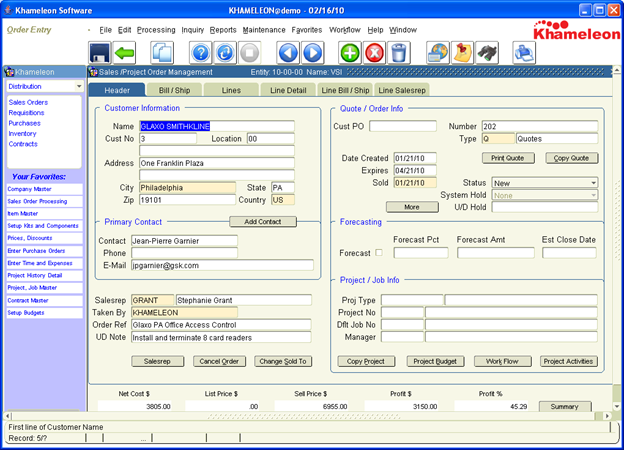Distribution> Sales Orders> Processing> Enter Sales Orders or Enter Sales Quotes
Quotation records in Khameleon can be created from the Enter Sales Quotes screen for users who have only been granted roles to Quotations, or from the Enter Sales Orders screen for users who have been granted roles to both.Quotation records can only be created for customer location records which exist in the customer master database. Please see CRM section A for instructions on customer location management & creation.
Header Tab
Upon entering the Sales Quote or Order Entry screen, the user must first select a customer record. This first customer record which appears in the upper left hand corner of the Header tab represents the Sold To location – or where the quotation itself is being PRESENTED. Users may utilize the list of values button, or type in values for Customer Name or Customer Number.
Once a customer record is selected, the primary contact person from the customer master record will populate the Primary Contact field. The Primary Contact may be changed using the list of values, or a new contact can be created using the Add Contact button.
The SalesRep field will populate a default value based on the SalesRep defined at the customer master. This value can be changed using the list of values button, or up to two additional SalesReps can be defined using the Salesrep button.
The Taken By field is always populated with an initial value of the current user.
The Order Ref field is a (50) character field used to identify what this particular quote or order is for. This field prints on the Quotation output as a Regarding line in the header section.
The UD Note field is a 2000 character field typically used to specify Scope of Work type details which also print on the Quotation output in a text box after the line items but before the total amount due fields.
The Change Sold To button can be used to facilitate a change in the Sold To customer up to the point that the Order record has been invoiced.

Once a customer record has been selected, in most cases the user can click the Save icon in the upper left which will generate and assign a sequential quote or order number. If the user does not currently belong to a sales department or if the customer requires a PO number, the system may prompt for these required values before Saving.
The primary Order types available are ‘Q’ for Quotes (default) and ‘O’ for Orders. The System Administrator can define additional detailed order types of Quotes and Orders – in the event that an organization may want to allow users to differentiate between standard Orders and new customer Orders – both having a type of ‘O’.
The Print Quote button can be used to generate a PDF output of the Quotation. The Copy Quote button can be used to create a new quote record based on the customer and line items present in the current record. See the Copying a Quotation or Order section below for additional details.
The system will maintain time stamp values for Date Created, Expires, and Sold. The Expiration timer is set at the Order Entry control record and has no functional properties beyond the display of an expiration date on the Quotation output.The Sold date initially is populated as the Created date, but is updated when a quote is converted to an order. This date may also be manually updated. The Sold date is primarily used for Booking and Sales Analysis BI reports.
The Status and System Hold buttons are not update-able by the user, and are set automatically if an order is placed on hold by the system for any reason. The System Administrator can define user hold codes to be used within Order Entry if desired.
There are (4) fields provided within the Forecasting frame of the Header canvas. These fields are typically used to indicate whether a Quotation record is forecast-able Yes or No, what the probability percentage is, what the fore-casted amount is, as well as when the sale is fore-casted to close. All (4) fields are used in a variety of BI reports targeting fore-casted sales.
The fields within the Project / Job Info frame are not required during the Quotation process unless the organization defines that pre-sales related time and expenses are tracked. These fields are typically populated downstream during the process where a Quote is turned into an Order and Confirmed.